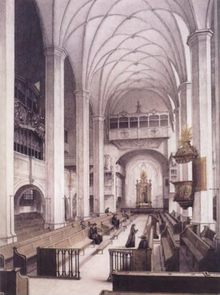Herr Christ, der einge Gottessohn, BWV 96
|
Herr Christ, der einge Gottessohn BWV 96 |
|
|---|---|
| Chorale cantata by J. S. Bach | |

Thomaskirche, Leipzig
|
|
| Occasion | 18th Sunday after Trinity |
| Performed | 8 October 1724: Leipzig |
| Movements | 6 |
| Cantata text | anonymous |
| Chorale | "Herr Christ, der einig Gotts Sohn" by Elisabeth Cruciger |
| Vocal | SATB choir and solo |
| Instrumental |
|
Herr Christ, der einge Gottessohn (Lord Christ, the only Son of God),BWV 96, is a church cantata by Johann Sebastian Bach. He composed the chorale cantata in Leipzig for the 18th Sunday after Trinity and first performed it on 8 October 1724. Part of Bach's second annual cycle, of mostly chorale cantatas, it is based on the hymn in five stanzas "Herr Christ, der einig Gotts Sohn" by Elisabeth Cruciger, published in Eyn geystlich Gesangk Buchleyn in 1524.
The hymn, related to mysticism and comparing Jesus to the Morning star, matches two aspects of the prescribed gospel for the Sunday, the Great Commandment and a theological dispute about the term "Son of David". An unknown poet kept the first and last stanza for the first and last movement of the cantata, and paraphrased the inner stanzas as four movements, alternating recitative and aria. Bach set the first stanza as a chorale fantasia with the cantus firmus in the alto, adding sparkle by a "dancing" soprano and the illumination of a sopranino, which he used for the first time in his cantatas. In the four inner movements, all four vocal parts have their solo. A tenor aria is accompanied by an obbligato transverse flute, a part written for a virtuoso player. A bass aria is accompanied by a oboes on one side, strings on the other, acting as in a Venetian concerto. The cantata is closed with a simple four-part setting of the hymn tune. Bach performed the cantata again in later years, with minor changes to the scoring.
...
Wikipedia
